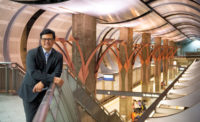 |
| Catching On. Johnson Controls is one of many owners going green. |
Proponents of sustainable buildings are grappling with technically difficult and politically charged issues, particularly relating to the use of refrigerants in mechanical systems. The issue rose to the surface recently with the announcement of a new way to rate chillers that contain hydrochlorofluorocarbons (HCFCs), in what has become the defacto standard of "greenness," the Leadership in Energy & Environmental Design rating system created by the U.S. Green Building Council.
USGBCs technical and scientific advisory committee has recommended revising the LEED "ozone-depletion" credit that rewards projects for not using HCFCs or halons in mechanical systems. The new credit will use a formula that will allow more freedom in refrigerant selection and will take into account potential for leakage and ozone depletion and the impact on global warming, said Nigel Howard, USGBC vice president, at the councils Greenbuild conference, Nov. 10-12, in Portland, Ore. The credit "will be more performance based."
Reaction to the credit revision is mixed. "This is good news," says Dan Nall, senior vice president, Flack & Kurtz, New York City. "The older version looked at the ozone depletion index only," he said. But less efficient systems "may have a global warming impact larger than the ozone depletion impact."
Other sources point to a U.S. Environmental Protection Agency schedule to ban import and production of many types of HCFCs by 2020. A complete ban will go into effect by 2030. "You are not doing the client a service by specifying a chiller with a phase-out date," said Rob Bolin, vice president for sustainable design at Syska Hennessy Group, Los Angeles. "A chiller should last more than 15 years."
|
The same USGBC committee also is studying possibility of including a credit in LEED for reducing the content of polyvinyl chloride (PVC) in buildings. Those that support avoiding PVC use say it is a source of dioxins. They point to studies that suggest a link between dioxin exposure and cancer as well as reproductive and developmental defects.
The plastics industry maintains that PVC is more durable and has better thermal properties than many of its alternatives and accounts for only 1% of dioxin production. A draft report from USGBC is expected next month.
Several other "sustainable" building announcements were made at Greenbuild, which drew 6,300 people. These include launch of a Mexico Green Building Council and licensing of LEED to the India Green Building Council.
USGBC also signed a memorandum of understanding with Chinas ministry of construction to cooperate on several efforts, including development of a rating system. Chinas system "may or may not be like LEED," said Howard.
In addition to expanding beyond the U.S., the council is adapting LEED to more types of projects. Last month, it released a version focusing on operation and maintenance of existing buildings and another addressing tenant space construction and renovation. The new versions join LEED-NC, which primarily is geared to commercial and institutional new construction. Adaptations tailored to the core and shell of speculative buildings, residential construction and neighborhood developments also are in the works.
 |
| Fedrizzi |
The council has grown phenomenally1,000% in the past four years alone, it says. There now are 5,300 member organizations, which include corporations, government agencies and nonprofits. Earlier this month, San Francisco and Boston announced requirements that city-owned projects achieve at least a silver LEED rating. Other users include Chicago; Austin, Texas; Seattle and Portland. Several federal agencies also have adopted LEED, including the General Services Administration and Dept. of State.
The council plans to add as many as fifteen key staff positions in 2005, said Rick Fedrizzi, who was appointed president and CEO in April. Fedrizzi is concerned about the organizations rapid growth. "I am literally trying to apply the brakes," he said. "I want to strategically look at what we have created."
(Photo top by U.S. Green Building Council, bottom by Joann Gonchar for ENR)


Post a comment to this article
Report Abusive Comment